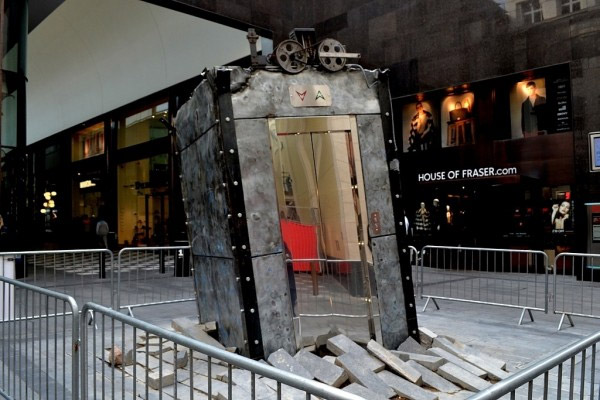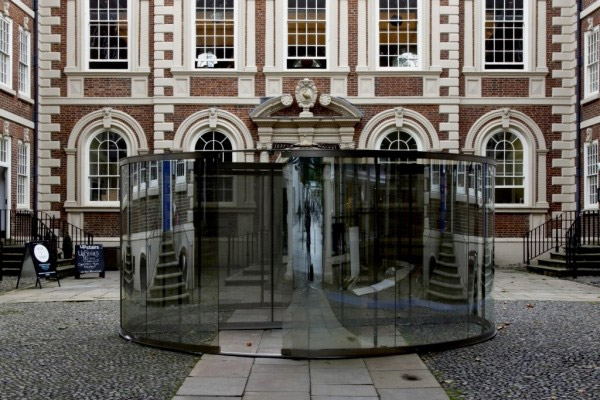
| HOME |
| NERVE |
| REVIEWS |
| ARCHIVE |
| EVENTS |
| LINKS |
| ABOUT US |
| CONTRIBUTORS |
| BACK ISSUES |
| CONTACT US |
Meeting the Surreal
Some experiences on the streets of Liverpool
By Sandra Gibson - 2/11/2012
As George Melly has demonstrated in his book Paris and the Surrealists, the surreal is fairly commonplace, especially in urban regions and especially in cities with lots of statues, such as Paris. The chance of a convergence between disparate objects, of strange dislocations, of scale playing tricks with the perception, is more likely to happen where there are buildings from various eras or groups of random objects (such as you see at antiques fairs), or a plethora of advertising material. Demolition is often the catalyst for surprising sights. We’ve all been amazed by the survival of one wall of pristine wallpaper when the rest of the building lies at its feet as rubble, or smiled when a seagull has perched on the head of Queen Victoria, or been intrigued to see the exposed layers of decades’ worth of posters with the irresistible juxtaposition of words and images. The whited-out mime artists who stand immobile for hours, impersonating statues, are a common experience in city centres but I am always caught unaware by them; I think it’s the stillness - so rare these days - as much as the ghastly paleness. Patrick Murphy’s installation Belonging (2012) involves 150 bright birds roosting at the Walker Art Gallery as a tribute to the urban pigeon, maligned as vermin. This has a similar effect to the statues, except that it is the brightness of the colour that surprises.
 |
A doorway is a common motif in art and literature; it can hide what is within or mark an opening from one place to another. It can offer an invitation to find what lies beyond, or be used as a territorial or hierarchical barrier. We are all familiar with the idea of the tradesmen’s entrance which reinforced the class system or the stage door with its possibility of meeting celebrity or the green door, behind which there was, according to Frankie Vaughan, “so much fun”. Elmgreen and Dragset’s VIP door: But I’m on the Guest List Too! (2012) at Liverpool One is surreal because it is made of a material not commonly used for door and door-frame making, is not attached to any building and cannot be opened. It has been divorced from its usual function and alludes to our contemporary class system which elevates the celebrity to a higher social level than the rest of us. Merely being married to a footballer or having done time in the Big Brother house can confer VIP status. The door is slightly ajar but won’t open any further - either way. And no-one can resist trying! Made of stainless steel, the door is reflective, so that everyone who approaches it also sees their own image - slightly distorted, like the (alleged) exaggerated self-image of those who belong to the VIP class.
Also in Liverpool One is Oded Hirsch’s The Lift (2012 - above). Unlike the shiny door, this is a dull lift shell that has lost its trappings, its social face, and has burst through the prestigious shopping area, like a diagonal gate crasher. As a metaphor for social mobility or alien landing or something that has forced its way into a place it should not be, it succeeds.
Positioned outside the Bluecoat, Dan Graham’s pavilion 2 Way Mirror Cylinder Bisected by Perforated Stainless Steel (2011-2012 - below) also exploits the properties of reflective surfaces, mirroring the ever changing light levels and the stream of people encountering their own image: pausing, reacting, entering the structure or just moving on. Or passing by without noticing it as anything out of the ordinary. In entering inside space we have expectations that the area will have a function familiar to us: retail, print shop, food provision, haircuts, administration of advice, living space, toilet…This space confronts us with our own image and those of others; with the way we alter our behaviour when looking at ourselves; with our voyeuristic tendencies when viewing others; with our natural curiosity which prompts us to go into places or come out of places.
 |
In a consumer society where everything is so hyper it’s difficult to find surprises. When the Surrealists were haunting the streets of Paris in the interwar years things were less hectic and the new ideas of the landscape of the subconscious were hot off the press from Freud’s notebooks. I think what has conventionally been considered surreal has been annexed by the media, especially in advertising, and is now commonplace. We need a new image of surrealism: pavements free of splattered chewing gum, parks without litter, shops with no Christmas decorations even though it’s already August, advertisements all in black and white, sober hen parties…
No - that’s definitely too radical.
Sorry Comments Closed
Comment left by Minnie Stacey on 2nd November, 2012 at 18:39
This is a great review and I especially like the surreal definition of the surreal that it ends with! YES TO THAT!